Address
AVSSO 2242 SE 171st AVE Portland Oregon USA 97233
Work Hours
Monday to Friday: 7AM - 7PM
Weekend: 10AM - 5PM
Address
AVSSO 2242 SE 171st AVE Portland Oregon USA 97233
Work Hours
Monday to Friday: 7AM - 7PM
Weekend: 10AM - 5PM
Bring your faith into your home by learning how to build an altar to God. Our simple instructions make it easy to create a personal place of worship.
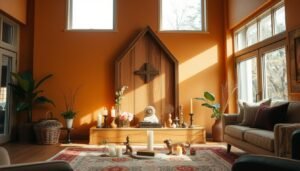
Building a dedicated space for worship in our homes can be a powerful way to deepen our spiritual practice and connect with the divine. Having a sacred space can bring a sense of peace and tranquility into our daily lives, providing a quiet refuge from the world’s chaos.
As we embark on this journey, we’re not just creating a physical space; we’re cultivating a spiritual environment that nurtures our faith and fosters a deeper connection with God. In this article, we’ll explore the significance of having a home altar and provide a step-by-step guide on how to create a meaningful and sacred space in your own home.
Creating a home altar is a meaningful way to deepen your spiritual practice and connect with God on a daily basis. A home altar is more than just a decorative piece; it is a sacred space that fosters spiritual growth and development.
We establish a home altar to create a focal point for our spiritual practices, allowing us to cultivate a deeper connection with our faith.
Home altars hold significant spiritual importance as they provide a dedicated space for prayer, reflection, and worship. By creating a sacred space in our homes, we can:
Designating a specific area for spiritual practice helps to distinguish it from other areas of the home, creating a sense of reverence and respect.
Physical symbols, such as candles, icons, and sacred texts, serve as tangible representations of our faith, facilitating a deeper connection with God.
The Bible provides numerous examples of altars and their significance in the religious practices of the ancient Israelites.
In the Old Testament, altars were constructed for worship and sacrifice, such as the altar built by Moses in Exodus 24:4.
The New Testament also references altars, emphasizing their role in Christian worship, as seen in Hebrews 13:10.
By understanding the biblical context of altars, we can appreciate the significance of having a home altar in our modern lives.
Building a home altar is a meaningful way to deepen your spiritual practice. It involves creating a sacred space that fosters a deeper connection with your faith. In this section, we will guide you through the initial steps of building your home altar.
The location of your altar is crucial for creating a conducive environment for prayer and reflection. You need to select a spot that is quiet and free from distractions.
When choosing a location, consider the foot traffic in your home. Avoid high-traffic areas to minimize distractions. Additionally, consider the proximity to windows and doors.
To create a distraction-free environment, turn off electronic devices nearby or place your altar in a room where you can control the noise level. This will help you maintain focus during your spiritual practices.
The size and style of your altar depend on the available space and your personal preferences. You can choose a compact design for small spaces or a more elaborate setup if you have ample room.
Your altar should complement your home’s décor. Consider the color scheme, furniture style, and overall aesthetic when designing your altar.
Measure your available space carefully to determine the ideal size for your altar. Consider the height, width, and depth to ensure it fits comfortably in the chosen location.
| Altar Size | Ideal Location | Style Considerations |
|---|---|---|
| Compact | Small rooms or corners | Simple, minimalist design |
| Medium | Living rooms or bedrooms | Balanced with surrounding décor |
| Large | Dedicated prayer rooms | Ornate, detailed designs |
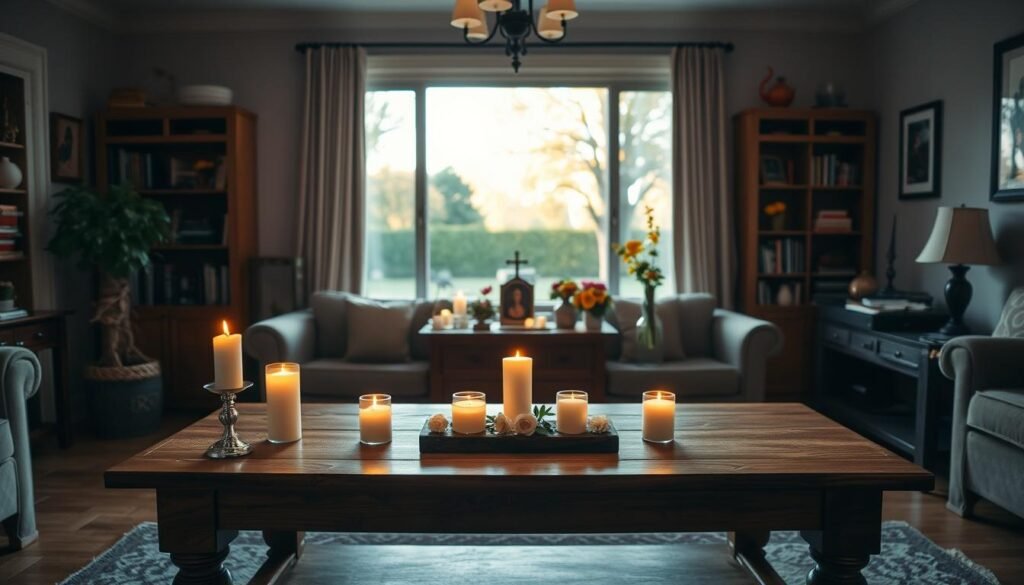
Incorporating meaningful elements into your home altar can enhance your spiritual experience. These elements help create a sacred space that fosters a deeper connection with your faith.
Sacred texts are a fundamental component of any home altar. They serve as a source of inspiration, guidance, and spiritual growth.
Display your Bible or religious texts prominently on your altar. You can use a decorative stand or place it on a designated shelf. This makes it easily accessible for reading and reflection.
Identify and highlight verses that hold special meaning to you. You can use bookmarks, sticky notes, or even annotate the text to make it more personal.
Candles and other light sources are not only symbolic but also create a serene ambiance. They represent the light of faith and guidance.
Light has long been a symbol of divine presence in many religious traditions. It signifies hope, purity, and enlightenment.
When using candles, ensure they are placed safely away from flammable materials. Never leave burning candles unattended.
Religious symbols and icons are powerful representations of faith. They can serve as reminders of spiritual commitments and values.
Select symbols that resonate with your personal beliefs and spiritual practices. This could include crosses, statues, or other icons significant to your faith.
Arrange your symbols in a way that feels respectful and meaningful. Consider creating a focal point on your altar where your most significant symbols are displayed.
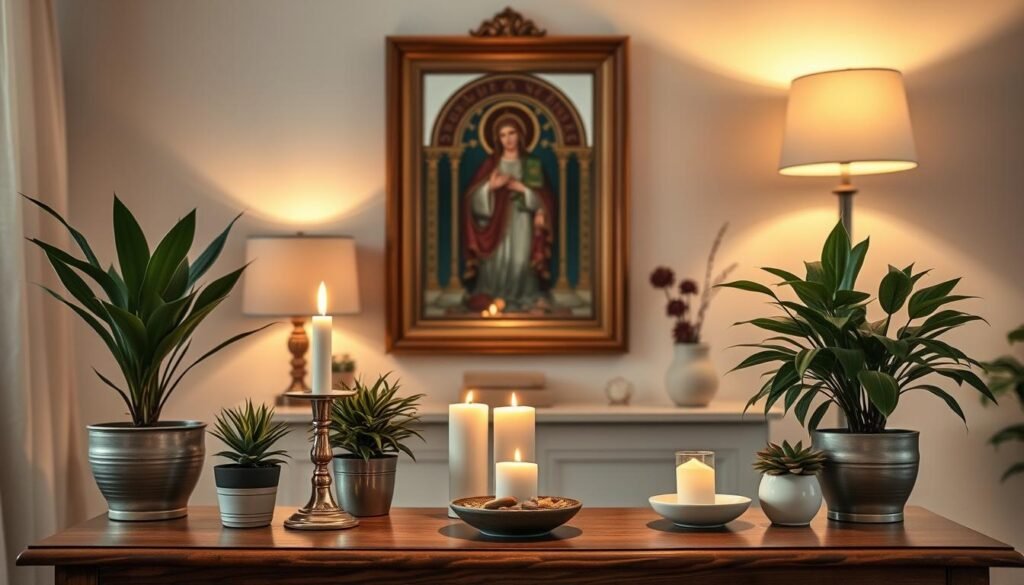
| Element | Significance | Tips for Inclusion |
|---|---|---|
| Sacred Texts | Source of inspiration and guidance | Display prominently, highlight meaningful verses |
| Candles/Light Sources | Symbolize faith, hope, and purity | Use safely, create a serene ambiance |
| Religious Symbols/Icons | Represent faith and spiritual commitments | Choose meaningful symbols, arrange respectfully |
Assembling a home altar requires a thoughtful approach to selecting materials and tools. The process involves not just constructing a physical space, but also creating a spiritual sanctuary that reflects your faith and values.
When it comes to building your altar, the base materials you choose are crucial. These materials will form the foundation of your altar, providing the necessary structure and support.
Wood is a popular choice for altar construction due to its durability and aesthetic appeal. You can choose from various types of wood, such as oak, pine, or cedar, depending on your preference and budget. Fabric can also be used to create a beautiful altar cloth or to cover the altar surface, adding a touch of elegance and reverence. Other base materials like metal or stone can be used to create a more contemporary or minimalist design.
To assemble your altar, you’ll need a set of basic tools. These may include a saw for cutting wood, a drill for making holes, a hammer for tapping pieces into place, and sandpaper for smoothing out the surfaces. Depending on the complexity of your design, you may also need additional tools like a jigsaw, sander, or clamps.
Once you have the basic structure of your altar in place, you can start adding decorative elements that reflect your personal style and spiritual practices.
Natural elements like flowers, stones, and plants can add a beautiful and meaningful touch to your altar. You can use seasonal flowers to create a vibrant display or select stones that hold spiritual significance. Plants like peace lilies or succulents can also be used to bring a sense of calm and serenity to your altar space.
Cloth coverings and colors can greatly enhance the aesthetic appeal of your altar. You can choose altar cloths in liturgical colors that correspond to different seasons or feasts in the church calendar. Alternatively, you can select fabrics that resonate with your personal taste and the overall decor of your home. Using different colors and textures can help create a visually appealing and spiritually inviting space.
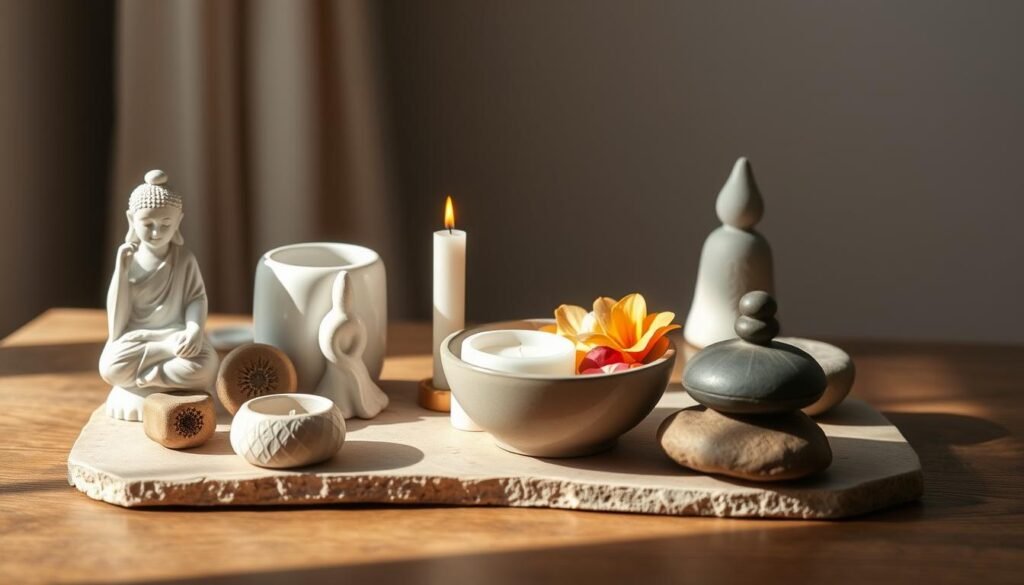
Building a home altar can be a meaningful way to deepen your spiritual practice. In this section, we’ll walk you through the process of constructing a home altar that reflects your faith, covering three main approaches: building a simple table altar, creating a wall-mounted altar, and repurposing existing furniture.
A simple table altar is a great starting point, especially if you’re new to creating sacred spaces. To begin, you’ll need a sturdy table or surface that can hold your sacred items.
Start by cleaning and preparing your table. You can use a new or existing piece of furniture, depending on what you have available. Ensure it’s stable and large enough to hold your essential items.
Consider adding a tablecloth or altar cloth to protect the surface and add a touch of elegance.
Once your surface is ready, you can begin arranging your sacred items. Start with the essentials, such as a candle, sacred texts, and religious symbols. Arrange them in a way that feels meaningful to you.
A wall-mounted altar is a great option if you have limited floor space. It can also add a beautiful focal point to your room.
To create a wall-mounted altar, start by securing shelves or brackets to the wall. Ensure they are level and can support the weight of your sacred items.
Use a level and sturdy brackets to avoid any accidents.
Once your shelves are secure, you can begin arranging your sacred items. Create a visual focus by placing your most meaningful items at the center.
Repurposing existing furniture is a great way to create a unique and meaningful altar. Consider using an old bookshelf or cabinet that can be transformed into a beautiful altar.
Start by cleaning and refurbishing your chosen furniture. Remove any unnecessary items and give it a fresh coat of paint or varnish if needed.
Once your furniture is refurbished, you can begin preparing it for use as an altar. Add a tablecloth or altar cloth to protect the surface and create a sense of reverence.
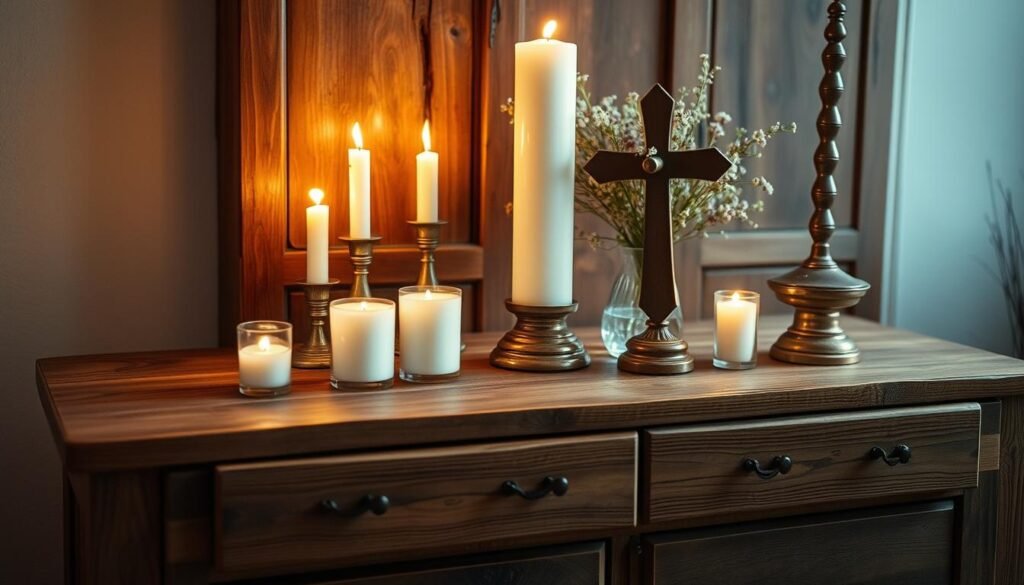
By following these steps, you can create a beautiful and meaningful home altar that reflects your faith and serves as a focal point for your spiritual practice.
Making your altar truly yours involves incorporating elements that reflect your faith and personal story. Personalizing your home altar is a meaningful way to enhance your spiritual practice and create a deeper connection with your sacred space.
Including family heirlooms on your altar can add a profound layer of personal significance. These items can serve as tangible connections to your heritage and faith traditions.
Using heirlooms that have been passed down through generations can honor your family’s faith traditions. For example, a vintage Bible or a rosary can be a beautiful addition.
Gifts received during significant spiritual milestones, such as a baptism or confirmation, can also be displayed. These items tell a story of your spiritual journey.
Beyond family heirlooms, there are many ways to add personal touches to your altar. These elements can make your altar a true reflection of your faith and spirituality.
Including prayer cards or journals on your altar can be a powerful reminder of your spiritual commitments. Writing down prayers and reflections can deepen your practice.
Artwork or handcrafted items that reflect your faith can also be meaningful additions. These could be icons, sacred art, or items crafted during spiritual retreats.
To keep your altar vibrant and relevant, consider making seasonal decorations and changes. This practice can help you stay connected to the liturgical calendar and the rhythms of the spiritual year.
Adjusting your altar decorations according to the liturgical calendar can enhance your spiritual practice. For example, adding Advent candles or Lent-themed decor can mark the seasons.
Decorating your altar for specific holidays, such as Christmas or Easter, can also be a meaningful tradition. These decorations can be a way to celebrate and reflect on the significance of these days.
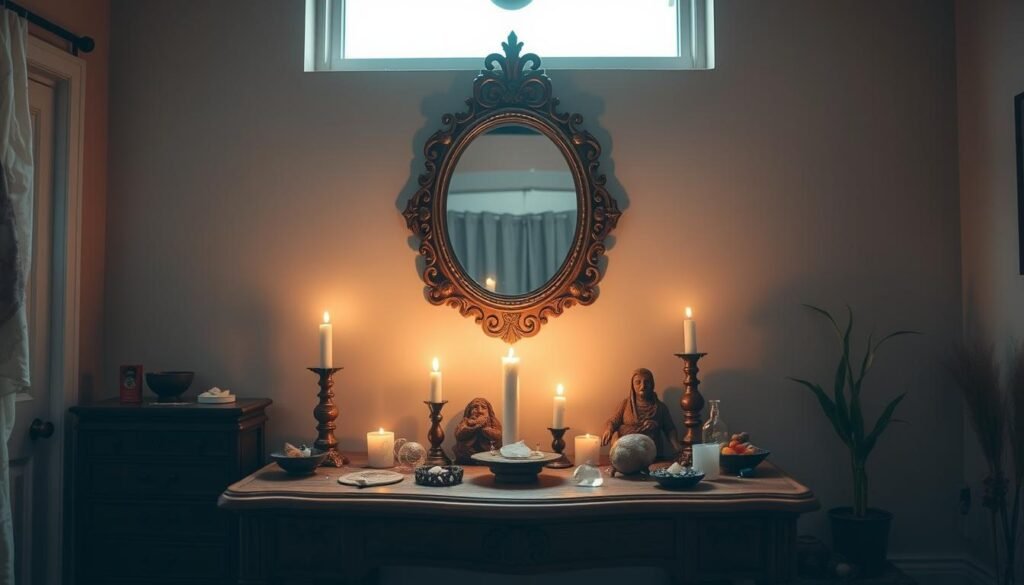
Dedicating your home altar is a meaningful step in creating a sacred space for worship and reflection. This act not only consecrates the physical structure but also infuses it with spiritual significance, making it a focal point for your family’s faith and devotion.
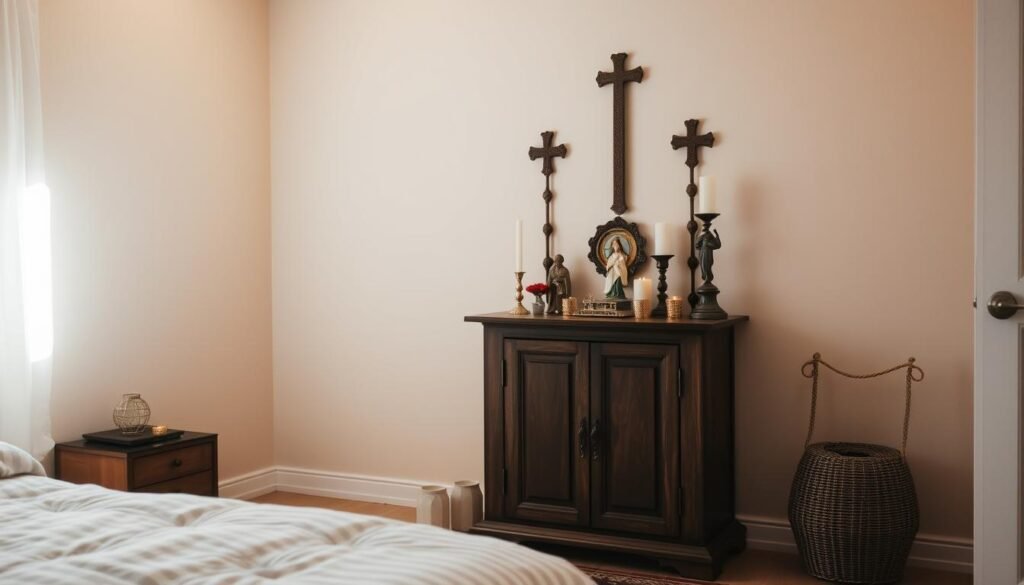
A dedication ceremony can be as simple or as elaborate as you wish. It typically involves prayer and may include a blessing by a clergy member. This ceremony is a crucial step in dedicating your altar to its intended purpose.
When writing a dedication prayer, consider expressing your intentions, gratitude, and hopes for the space. You can draw inspiration from religious texts or personal experiences.
Inviting a clergy member to bless your altar can add a layer of spiritual authenticity. They can perform a blessing ceremony, invoking divine presence in your home.
Family participation is key to making the dedication ceremony meaningful. Involve your family members in the process to create a sense of unity and shared purpose.
To create a meaningful ceremony, consider including elements that are significant to your family’s faith, such as sacred texts, symbols, or rituals.
It’s also important to explain the significance of the altar to children, helping them understand its role in your family’s spiritual life.
| Ceremony Element | Significance | Involvement |
|---|---|---|
| Prayer | Spiritual Invocation | Family Members |
| Blessing by Clergy | Divine Presence | Clergy Member |
| Sacred Texts | Guidance and Wisdom | Family Reading |
Once your home altar is built, it’s essential to understand how to use and maintain it effectively. A well-maintained altar can become a vibrant part of your family’s spiritual life, fostering a deeper connection with your faith.
Establishing daily devotional practices is crucial for making the most of your home altar. This can include various rituals that help you connect with your spirituality.
Starting and ending your day with prayers at your altar can create a sense of calm and purpose. It’s a moment to reflect on your day, express gratitude, and seek guidance.
Reading scripture and meditating at your altar can be a powerful way to deepen your understanding of your faith. Take time to reflect on the readings and how they apply to your life.
Involving your family in prayer time can strengthen your bond and create lasting memories. It’s an opportunity to teach children about the importance of faith and spirituality.
Regular family prayer sessions can become a cherished tradition. It’s a time to come together, share your thoughts, and support one another.
Involving children in the care and use of the altar teaches them to respect sacred spaces. This helps them understand the significance of the altar in your family’s spiritual life.
To keep your altar a meaningful and beautiful part of your home, regular care is necessary. This includes cleaning, maintaining, and occasionally updating the elements on your altar.
Dust and clean your altar regularly to keep it looking its best. Check for any damage or wear on the items and replace them as needed.
Periodically refresh your altar by changing the decorations or adding new elements. This keeps the space feeling fresh and relevant to your current spiritual journey.

Building a home altar is a meaningful way to deepen your faith journey and create a sacred space in your home. By following the steps outlined in this article, you can create a beautiful and functional altar that reflects your personal style and spiritual practices.
As you dedicate your altar and begin using it for daily devotional practices, you’ll find that it becomes a source of comfort, inspiration, and guidance. We encourage you to embark on this meaningful project and experience the benefits of having a home altar firsthand.
By incorporating a home altar into your daily life, you’ll be able to cultivate a deeper sense of spirituality and connection with your faith. This sacred space will serve as a reminder of your values and principles, helping you stay focused on your faith journey.